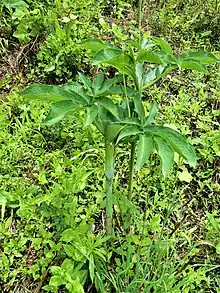| Arisaema heterophyllum | |
|---|---|
 | |
| Scientific classification | |
| Kingdom: | Plantae |
| Clade: | Tracheophytes |
| Clade: | Angiosperms |
| Clade: | Monocots |
| Order: | Alismatales |
| Family: | Araceae |
| Genus: | Arisaema |
| Species: | A. heterophyllum |
| Binomial name | |
| Arisaema heterophyllum | |
Arisaema heterophyllum, the dancing crane cobra lily, belongs to the monocotyledonous flowering family Araceae.[1] It is a perennial, rhizomatous herb native to East Asia.[1][2] It has a spadix inflorescence and can be recognized by its green spathe and comparatively smaller central leaflet.[3]
The rhizome is often used in Chinese traditional medicine as a treatment for coughs, epilepsy, and tetanus.[3] It is prepared using ginger and potassium aluminum sulphate for purifying purposes.[4]
Description
The roots are tubular, depressed globose shaped, and around 2–6 cm in diameter.[3] The usually solitary leaves are around 30–60 cm long, with glaucous petioles and sheathing adjacent to the pseudostem.[2] They are sedately divided, adaxially dull green and abaxially pale green, and contain 4 or 5 cataphylls and multiple leaflets, ranging from 11 to 21 in number.[2] The central leaflet is 3–15 cm long and 0.7-5.8 cm wide; the outermost leaflets are smaller. The distance between leaflets is around 0.5–5 cm.[2] The leaves have a variety of shapes, such as oblanceolate, oblong, linear-oblong, base cuneate, and apex cuneate.[3]
The peduncle of the flower is around 50–80 cm long, and is usually longer than the petiole.[3] The flower also has a spathe tube that is cylindrical, 3.2–8 cm long, 1-2.5 cm wide, outside glaucous, inside whitish green, and its throat is slightly recurved.[2] The spadix of the flower is either bisexual or monoecious and male.[3] In the female part of the bisexual spadix it has a punctate stigma, a distinct style, and a globose ovary that contains 3 to 4 ovules; the male part contains sterile flowers.[3] The anthers of the male spadix has thecae dehiscing by the apical slits.[3] The pale white sigmoid appendix is 20 cm long, ascending, and gradually tapers from the sessile base to sharp apex.[2] The flowering period usually starts in April or May, and continues from July to September.[3] The fruits are cylindrical yellowish red or red berries that usually have 1 seed.[3]
Distribution and habitat
Arisaema heterophyllum is native to East Asia, including China, Inner Mongolia, Japan, and Korea.[5] In China, it is grown across different provinces except for the Northwest region and Tibet.[6] In Japan, it is grown in Honshu and Kyushu.[7]
The species tends to grow in evergreen and deciduous riparian forests, shrublands, wetlands (inland) or grassland where shade is available and moisture is retained.[1][7] It is closely associated with flood plains and prefers humus-rich and well-draining soil. The tuber is intolerant to low temperatures.[1] In Japan, it is considered a threatened species due to the loss of riparian forest along the major rivers of Kanto Plain.[8]
Genetics
The plant contains Arisaema heterophyllum agglutinin (AHA),[9] a substance that can cause blood particles to coagulate and aggregate. It was revealed that AHA had negative effects towards the feeding behaviour of the Indian Grain Aphid (Sitobion miscanthi), causing the aphids' lifespan to reduce significantly.[9] Resistance towards Indian Grain Aphids in wheats was observed to have improved after intruding AHA to the plants.[9]
Traditional use of Arisaema
Many species within the genus Arisaema have medicinal uses in Chinese medicine.[3]
References
- 1 2 3 4 Crook, V. (2008-10-08). "IUCN Red List of Threatened Species: Arisaema heterophyllum". IUCN Red List of Threatened Species.
- 1 2 3 4 5 6 Xu, Zhenghao; Chang, Le (2017), Xu, Zhenghao; Chang, Le (eds.), "Araceae", Identification and Control of Common Weeds: Volume 3, Singapore: Springer, pp. 765–785, doi:10.1007/978-981-10-5403-7_25, ISBN 978-981-10-5403-7, retrieved 2021-12-06
- 1 2 3 4 5 6 7 8 9 10 11 "Arisaema in Flora of China @ efloras.org". www.efloras.org. Retrieved 2021-12-06.
- ↑ Guo, Ping; Brand, Eric; Zhao, Zhongzhen (2015-12-18), Heinrich, Michael; Jäger, Anna K. (eds.), "Chinese Medicinal Processing: A Characteristic Aspect of the Ethnopharmacology of Traditional Chinese Medicine", Ethnopharmacology, Chichester, UK: John Wiley & Sons, Ltd, pp. 303–316, doi:10.1002/9781118930717.ch26, ISBN 978-1-118-93071-7, retrieved 2021-12-06
- ↑ "Arisaema heterophyllum Blume | Plants of the World Online | Kew Science". Plants of the World Online. Retrieved 2021-12-06.
- ↑ "天南星 Arisaema heterophyllum|iPlant 植物智——植物物种信息系统". www.iplant.cn. Retrieved 2021-12-06.
- 1 2 Muraoka, Hiroyuki; Tang, Yanhong; Terashima, Ichiro; Koizumi, Hiroshi; Washitani, Izumi (2000). "Contributions of diffusional limitation, photoinhibition and photorespiration to midday depression of photosynthesis in Arisaema heterophyllum in natural high light". Plant, Cell & Environment. 23 (3): 235–250. doi:10.1046/j.1365-3040.2000.00547.x. ISSN 1365-3040.
- ↑ Oshima, Kazunobu; Tang, Yanghong; Washitani, Izumi (September 1997). "Spatial and seasonal patterns of microsite light availability in a remnant fragment of deciduous riparian forest and their implication in the conservation ofArisaema heterophyllum, a threatened plant species". Journal of Plant Research. 110 (3): 321–327. doi:10.1007/BF02524930. ISSN 0918-9440. S2CID 34501029.
- 1 2 3 Zhang, Yong; Deng, Qing; Chen, Julian (September 2021). "Transgenic expression of Pinellia ternata agglutinin (PTA) and Arisaema heterophyllum agglutinin (AHA) in wheat confers resistance against the grain aphid, Sitobion miscanthi". Journal of Pest Science. 94 (4): 1439–1448. doi:10.1007/s10340-021-01346-7. ISSN 1612-4758. S2CID 233965799.